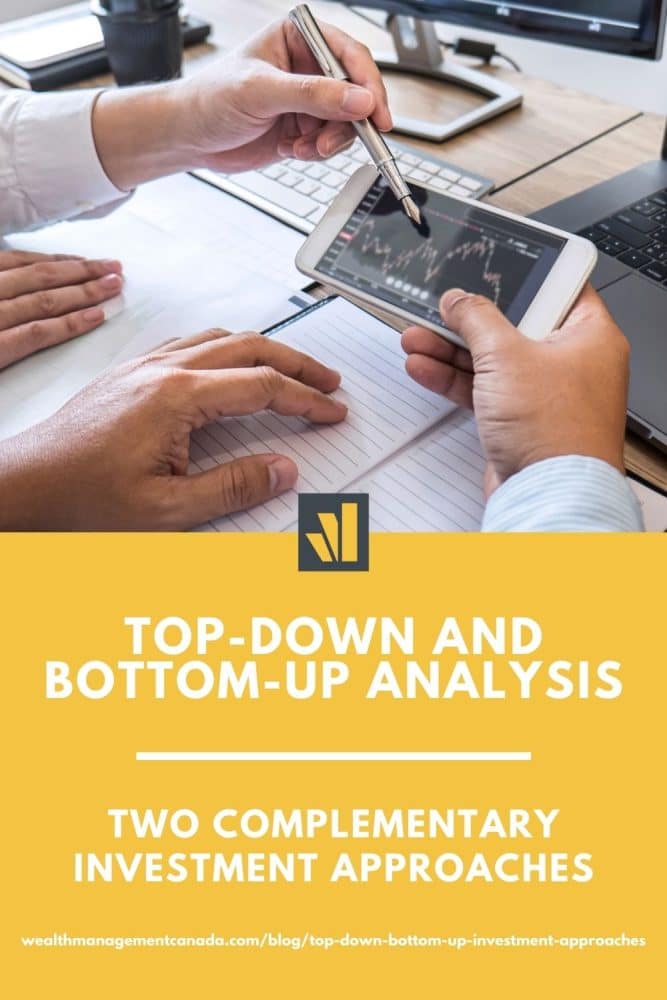Previously, we discussed the different investment styles wealth managers typically follow, including the growth vs. value styles. We looked at the reasons behind why some wealth managers tend to favour large-cap stocks over smaller capitalization companies or vice versa. A wealth manager’s investment philosophy can also be analyzed in terms of the approach they use when developing forecasts for markets, sectors, and individual companies.
The two most widely followed investment philosophies in this respect are top-down and bottom-up investing approaches.
In this post, we’ll compare these two investment philosophies. We’ll also look at how they can be used in tandem. Essentially, both approaches wealth managers develop more complete and accurate forecasts as part of their portfolio management strategy.

Table of contents
What is the Top-Down Investment Approach?
When conducting a top-down analysis, wealth managers will begin by analyzing the outlook for several key macroeconomic variables. This helps them come up with forecasted returns for different asset classes.
What do analysts consider when formulating their expected returns for assets like stocks, bonds, real estate, and commodities? High-level, broad factors like:
- Gross Domestic Product (GDP)
- The level and direction of interest rates
- The extent of unemployment present in the economy
- Expectations like future inflation
This analysis is used by wealth managers to help them identify the asset classes, sectors, and markets they believe will have the best chance of outperforming the market over the forecast period. The top-down approach is particularly valuable to wealth managers pursuing a tactical asset allocation strategy rather than one focusing on making individual security selections.
What is the Bottom-Up Investment Approach?
The top-down approach focuses primarily on the analysis of macroeconomic variables. A bottom-up analysis places emphasis on the outlook for certain key microeconomic, or company-specific, factors.
Before arriving at an outlook for future earnings and sales growth, bottom-up analysts (sometimes referred to as ‘fundamental’ analysts) conduct thorough due diligence on factors like:
- The prospects for a company’s products
- The technology employed
- New services expected to come to market
Fundamental analysts also consider internal factors such as a company’s management and personnel, its historical operating performance, and planned strategic initiatives.
The analyst then incorporates the findings from their research as part of a valuation model. This helps determine if the company’s shares or over or undervalued relative to the rest of the market.
Some wealth managers may also opt to take the level of analysis one step further by aggregating their forecasts for individual companies in order to arrive at an outlook for a specific industry, sector, or geography.
Related Reading: Asset Management vs Wealth Management: What is the Difference?
Top-down Approach vs. Bottom-up Approach
As a general rule, the top-down approach begins with a high-level view of the global economy. From there, it moves toward a narrower view of specific asset classes and global industries.
The bottom-up approach, meanwhile, starts from the specifics and moves towards a more general view of the overall economy.
Most portfolio managers find it’s best to employ both approaches when developing their economic forecasts.
Why? More often than not these two different approaches end up yielding disparate outlooks for the markets they are purporting to represent.
For example, there have been criticisms that the bottom-up investment approach has at times been overly optimistic at market peaks. At the same, they’re overly pessimistic at market troughs, or bottoms.
The most frequent criticism of top-down analysis is that it tends centre around the extrapolation of recent history while trying to predict the future. The concern? This carries the risk of sometimes leaving investors unprepared for unexpected exogenous shocks to the economy.
In this respect, reconciling top-down and bottom-up forecasts can prove a valuable exercise for analysts and wealth managers. It helps them to better appreciate the underlying consensus held by the overall market. It also presents a better picture of the rationale in support of any discrepancies between the two approaches.
A decade ago, real estate analysts alerted their superiors to the excesses taking place within the U.S. residential housing market. These analysts were instrumental in helping their firms re-evaluate what — in hindsight — were overstated forecasts for economic returns.
By doing so these analysts would have also helped their wealth manager’s clients avoid outsized losses that led to the eventual collapse of Lehman Brothers.
Takeaways
The more complete an understanding that an investor has about his or her wealth manager’s investment philosophy, the more productive and enjoyable that relationship stands to be.
Investors and their advisors can work together to foster an environment of open communication about the philosophies and thought processes that go into the investment management framework.
Ultimately, investors will be in a better position to know what questions they should be asking of their wealth manager. They’ll also be able to respond to their advisor’s explanation of the activity taking place within their investment account.
Read More: Evaluating a Wealth Manager: The 4P’s of Manager Research
Wealth Management Canada was created to provide access to the best financial resources, so you can invest your money wisely and make informed decisions.
Get started by completing our online questionnaire or send us a message through our contact form.